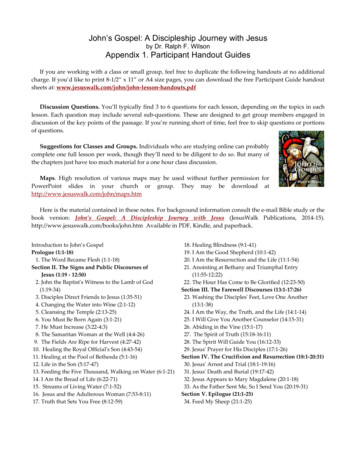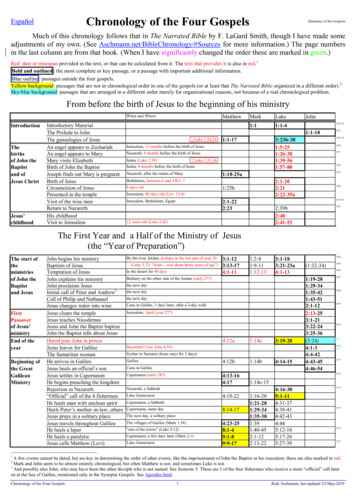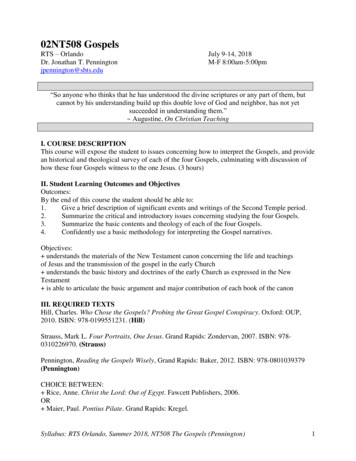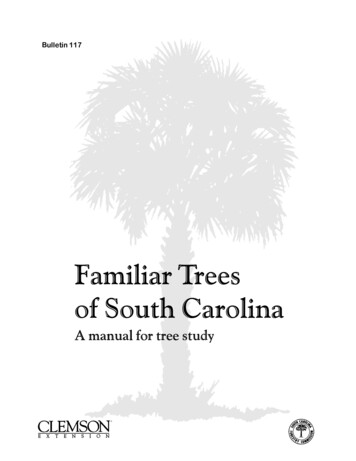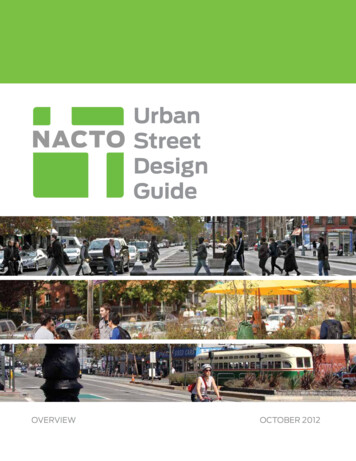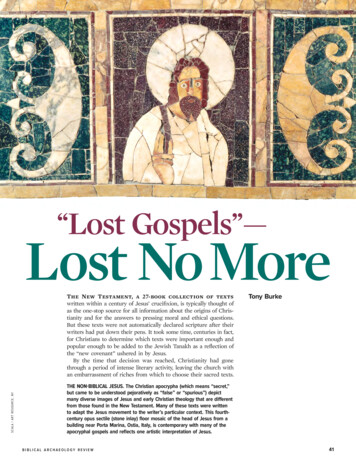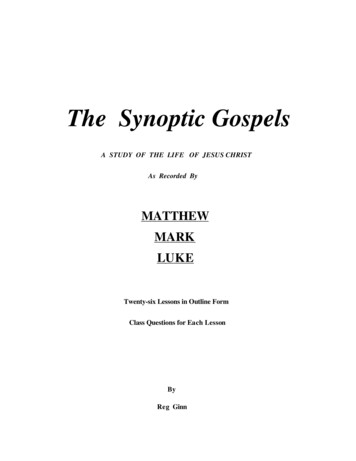
Transcription
The Synoptic GospelsA STUDY OF THE LIFE OF JESUS CHRISTAs Recorded ByMATTHEWMARKLUKETwenty-six Lessons in Outline FormClass Questions for Each LessonByReg Ginn
The Synoptic GospelsA STUDY OF THE “SAME EYE” REPORTSOF THE LIFE OF CHRISTMatthewMarkLukeTwenty-six Lessons with Class QuestionsByReg Ginn
TABLE OF CONTENTSPageOverview of Lessons .iIntroductory Notes on the Four Gospels .1Introductory Notes on the “Synoptic” Gospels .3Lesson One-- The Early Years .4Lesson Two-- The Early Years (continued) .11Lesson Three-- Early Events .16Lesson Four-- Galilean Ministry (1) .21Lesson Five-- Galilean Ministry (2) .28Lesson Six-- Galilean Ministry (3) .34Lesson Seven-- Galilean Ministry (4) .39Lesson Eight-- Galilean Ministry (5) .44Lesson Nine-- Galilean Ministry (6) .50Lesson Ten-- Galilean Ministry (7) .55Lesson Eleven-- Galilean Ministry (8) .61Lesson Twelve-- Galilean Ministry (9) .67Lesson Thirteen-- Galilean Ministry (10) .72Lesson Fourteen-- Galilean Ministry (11) .78Lesson Fifteen-- Perean Ministry (1) .84Lesson Sixteen-- Perean Ministry (2) .90Lesson Seventeen-- Perean Ministry (3) .97
TABLE OF CONTENTS (continued)PageLesson Eighteen-- Perean Ministry (4) .103Lesson Nineteen-- Perean Ministry (5) . 109Lesson Twenty-- The Final Week (1) . 115Lesson Twenty-one-- The Final Week (2) . 120Lesson Twenty-two-- The Final Week (3) . 127Lesson Twenty-three-- The Final Week (4) . 133Lesson Twenty-four-- The Final Week (5) . 138Lesson Twenty-five-- The Final Week (6) . 144Lesson Twenty-six-- The Forty Days . 152CHARTSGeneology of Christ .5The Apostles of Christ .58The Rich Young Ruler and the Ten Commandments . 106The Final Week . 158Chronology of the Last Days of Jesus . 159Appearances of Jesus Following His Resurrection . 160
Jesus ChristJesus of Nazareth, without money and arms, conquered more millions than Alexanderthe Great, Caesar, Mohammed, and Napoleon; without science and learning, he shed morelight on things human and divine than all philosophers and scholars combined; withouteloquence of school, he spoke such words of life as were never spoken before or since, andproduced effects which lie beyond the reach of orator or poet; without writing a single line,he set more pens in motion, and furnished themes for more sermons , orations, discussions ,learned volumes, works of art, and songs of praise than the whole army of great men ofancient and modern times. -- Philip SchaffHere is a man who was born in an obscure village, the Child of a peasant woman. Heworked in a carpenter shop until He was thirty, and then for three years He was an itineratepreacher. He never wrote a book. He never held an office. He never owned a home. Henever had a family. He never went to college. He never put His foot inside a big city. Henever traveled two hundred miles from the place where He was born. He never did one of thethings that usually accompany greatness. He had no credentials but Himself. He had nothingto do with this world except the naked power of His Divine manhood. While still a young man,the tide of popular opinion turned against Him. He was turned over to His enemies. He wentthrough the mockery of a trial. He was nailed to a Cross between two thieves. His executioners gambled for the only piece of property He had on earth while He was dying--and that wasHis coat. When He was dead He was taken down and laid in a borrowed grave through thepity of a friend. Such was His human life--He rises from the dead. Nineteen wide centurieshave come and gone and today He is the Centerpiece of the human race and the Leader of thecolumn of progress. I am within the mark when I say that all the armies that ever marched,and all the navies that ever were built, and all the parliaments that ever sat, and all the kingsthat ever re igned, put together, have not affected the life of man upon this earth as powerfullyas has that One Solitary Life. -- James C. HefleyAs the centuries pass, the evidence is accumulating that, measured by His effect onhistory, Jesus is the most influential life ever lived on this planet. -- Historian KennethScott Latourette
THE LIFE OF CHRIST IN THE SYNOPTIC GOSPELS-- Lesson OverviewsLESSONMatthew1. Early Years:a. Geneologies1:1-17b. John’s birth promisedc. Announcement to Maryd. Announcement to Joseph 1:18-25c. Mary visits Elizabethd. John’s birthMark4. Galilean Ministry-- (1)a. Beginning workb. Rejection at Nazarethc. Removal to Capernaumd. Call of four disciplese. Miracles in Capernaumf. First preaching tourg. Healing a paralytich. Call of Matthewi. Question about fastingj. Plucking graink. Healing a witherd handl. Widespread famem. Choosing of 11:39-561:57-802. Early Years (continued):a. Jesus’ birth1:18-25b. Angels and shepherdsc. Circumcisiond. Presentation in templee. Wise men visit2:1-12f. Sojourn in Egypt2:13-23g. Childhood in Nazareth2:23h. Visit to Jerusalemi. Eighteen years in Nazareth3. Early Events:a. Ministry of Johnb. Baptism of Jesusc. Temptations(Early ministry))d. Departure from 23:13-194:14,154:16-304:315:1-114:31-414:42-44; -16
THE LIFE OF CHRIST-- Lesson OverviewsPage 2LESSONMatthew5. Galilean Ministry-- (2)a. Sermon on the Mount6. Galilean Ministry-- (3)a. Sermon on the MountMark5:1- 6:22Luke6:20-366:22- 7:2912:22-31; 11:9-136:37-497. Galilean Ministry-- (4)a. Centurion’s servantb. Widow’s son at Nainc. John’s last messaged. Anointing of Jesuse. Christ’s companionsf. An “eternal” sing. Christ’s :11-177:18-357:36-508:1-311:14-238:19-218. Galilean Ministry-- (5)a. Parables by the :26-398:40-568:5-1311:2-309. Galilean Ministry-- (6)a. Stilling the storm8:23-27b. Gadaarene demoniacs8:28-34c. Jairus’ daughter9:18-26d. Healing blind and dumb9:27-34e. Second Nazareth rejection 9:54-58f. Third tour continued9:3510. Galilean Ministry-- (7)a. Mission of the Twelveb. Death of John(John)9:36- 11:114:1-1211. Galilean Ministry-- (8)a. Feeding five thousand14:13-21(Record of events in John’s gospel)b. Walking on water14:24-36c. Unwashed hands15:1-20(Record of events in John’s 6:1-15)6:47-567:1-23(6:16-21)
THE LIFE OF CHRIST-- Lesson OverviewsLESSONMatthew12. Galilean Ministry-- (9)a. The Syrophoenician15:21-28b. Miracles of healing15:29-31c. Feeding four thousand15:32-38d. A “sign from heaven”15:39-16:12e. Healing a blind man13. Galilean Ministry-- (10)a. Peter’s confessionb. Foretelling deathc. The transfiguration16:13-2016:21-2817:1-1314. Galilean Ministry-- (11)a. Demoniac boy healed17:14-20b. Foretelling death again17:22,23c. Shekel in fish’s mouth17:24-27d. Humility, forgivenesschapter 18(Record of events in John’s gospel)Page 39:33-509:37-439:43-4515. Perean Ministry-- (1)a. Final departure19:1,2; 8:18-22 10:1b. Mission of the Seventyc. The “good” Samaritand. Visit to Mary, Martha(Record of events in John’s gospel)e. Discourse on prayerf. Discourse against Pharisees9:46-50(chapters 7,8)9:51-6210:1-2410:25-3710:38-42(chapters 8,9,10)11:1-1311:37-5416. Perean Ministry-- (2)a. Trust and judgmentb. Slain Galileansc. Woman healed on sabbathd. Few are saved?e. Reply to Herod’s threatf. The great supper22:1-14g. Counting the costchapter 1213:1-913:10-2113:22-3013:31-3514:1-2414:25-3517. Perean Ministry-- (3)a. Three parables of the “lost”b. Two warnings about faithfulnesschapter 15chapter 16
THE LIFE OF CHRIST-- Lesson OverviewsLESSON17. (continued)c. Ten lepersMatthewPage 4MarkLuke(Record of events in John’s gospel)(chapter 11)17:11-1918. Perean Ministry-- (4)a. Coming of the kingdomb. Pharisees and publicansc. Concerning divorce19:3-12d. Blessing children19:13-15e. Rich young ruler19:16-20:1619. Perean Ministry-- (5)a. Crucifixion foretoldb. Apostles’ ambitionc. Blind men healedd. Visit to Zacchaeuse. Parable of the poundsf. Anointing of 019:11-2820. The Final Week-- (1)a. Triumphal entry21:1-11(Record of events in John’s gospel)b. Cursing the fig tree21:18-22c. Second temple cleansing 21:12-17d. Fig tree . The Final Week-- (2)a. Authority challenged21:23-27b. The Son rejected21:28-46c. Three “trick” questions 22:15-40d. Unanswerable question 22:41-46e. Woe to scribes, Pharisees 23:1-39f. Widows’ 420:1-820:9-1920:20-4020:41-4420:45-4721:1-422. The Final Week-- (3)(Record of events in John’s gospel)a. Jerusalem’s destruction chapters 24,2523. The Final Week-- (4)a. Betrayal by Judas26:1-5, 14-1611:1-1119:29-44(12:12-19)(12:20-50)chapter 1321:1-614:1,2,10,11 22:1-6
THE LIFE OF CHRIST-- Lesson OverviewsPage 5LESSONMatthew23. (continued)b. The Last Supper26:17-30(Record of events in John’s gospel)c. Farewell discourses26:31-35(Record of events in John’s gospel)24. The Final Week-- (5)a. Agony in Gethsemane 26:36-46b. Betrayal and arrest26:47-56(Record of events in John’s gospel)c. Trial before Jews26:57-27:1(Record of events in John’s gospel)25. The Final Week-- (6)a. Trial before Pilate27:11-31b. The crucifixion27:32-56c. The burial27:57-61d. Watching the tomb27:62-66(Record of events in John’s gospel)26. The Forty Daysa. Resurrection morning 28:1-10(Record of events in John’s gospel)b. Guards’ report28:11-15c. Road to Emmausd. First appearance to disciples(Record of events in John’s gospel)(Second appearance to disciples)(Third appearance to disciples)e. Fourth appearance and commission28:16-20f. 4:44-4924:50-53
The Synoptic GospelsINTRODUCTORY NOTES ON THE FOUR GOSPELS1. Some students new to Bible study are surprised to find FOUR gospel accounts of Jesus’ lifeand work on earth.a. He was here less than four years.b. Only one-tenth of His lifespan is addressed in the accounts we have.c. Little is revealed about His family background or His youthful years.d. Nothing at all is included to describe His physical appearance.2. Is it possible that what the four accounts cover could just as easily be treated in one book ofthe Bible?3. This conclusion (above) is based on a lack of understanding about the divine reason behindthere being four, and not one, records of the most important life ever lived on this earth andwhy the reporting of that life is so incomplete, as measured by most biographies, despite thedevotion of the first four books of the New Testament to its reporting.4. Even casual readers of the four Gospels are impressed not only with the similiarities amongthem but also with the differences found in those Gospels.5. Several possibilities might be considered to account for similarities and differences:a. Differences resulted from mistakes made by self-directed writers. But, belief in the verbalinspiration of the Scriptures disallows any such explanation. Furthermore, the differencesamong the accounts do not constitute necessary contradictions. Each one can be explainedwithin the context of divine inspiration and purpose in the production of the Bible.b. Similarities are often attributed to collusion among the writers to produce four harmoniousrecords in an attempt to overwhelm the minds of those who might not be convinced bythe testimony of only one person who claims to be a witness of the facts recorded. However, the four Gospels are not totally identical in detail. The differences are numerous.Collusion would have suggested the exclusion rather than the inclusion of so many, so asto stress the unity rather than the diversity among writers and to make the record “appear”to be genuine.c. A “multiple source” theory is advanced by some to explain similarities and differences(1)
among Matthew, Mark, Luke and John in their treatment of: [1] subject matter; [2] vocabulary; [3] order of events included:(1) An “original” gospel which has not survived provided the material from which ourGospels selected their facts;(2) All the Gospels drew from early oral reports by numerous eyewitnesses whoserecollections, in keeping with human memory, were not always consistent;(3) A large number of short and uninspired narratives were written early on and were lateremployed as sources by the Gospel writers. See Luke 1:1;(4) Two “original” gospels were first written and made available to Matthew, Luke, andJohn:(a) A document identified with the book of Mark which Matthew and Luke used assource material;(b) Another document (called “Q”) which was different from the first document (Mark)and was also used by Matthew and Luke in writing their Gospels.(5) Other theories propose numerous source materials from which all four writers drewindependently.6. The Bible believer must contend that the source of materials for all four Gospel accounts isthe mind of God! The writers wrote just the things that were dictated to them by the HolySpirit (1Corinthians 2:6-16).7. The messages recorded in the four Gospels directly reflect God’s purpose to transmit a complete representation of our multi-faceted Savior. He is many things to many people in Hiswork as Redeemer of the world. Each Gospel in turn emphasizes something peculiar in HisPerson and work, while preserving those commonalities essential to the salvation of all men:a. Matthew stresses His role as King over His Kingdom and the fulfillment of prophecy aboutthat role. Jews would be attracted by this emphasis;b. Mark pictures Jesus as He serves among men while employing the full authority and powerof the Almighty Jehovah. People whose lives were controlled by the authoritative Romangovernment might be duly impressed by this portrayal of the Christ;c. Luke is concerned with showing Jesus as the Son of Man who is dedicated to the salvationof all men. This message would especially appeal to a Gentile audience;d. John appears to focus most on the divinity of Jesus and on the relationship between theFather and the Son. He is the only Savior of mankind because of that relationship. John’smessage would be welcomed by the whole world.(2)
INTRODUCTORY NOTES ON THE “SYNOPTIC” GOSPELS1. There are distinct and significant differences between the first three Gospels and the Gospelof John.2. Matthew, Mark and Luke emphasize:a. The miracles and parables of Jesus;b. Many everyday events in the life of Jesus;c. Events taking place primarily in Galilee.3. John emphasizes:a. Theological discussions, often lengthy;b. Fewer events, but with much more accompanying explanations;c. Events occurring principally in Judea.4. The first three Gospels are often called “Synoptic Gospels” because they seem to “see”Christ’s activities with “one eye” much more than John did.5. The Gospel of Matthew:a. Date-- 50-60 A.D. (Certainly before the destruction of Jerusalem in 70 A.D.)b. Purpose-- To encourage and establish Jewish Christians in the faith; to confute their adversaries; to prove to all that the Gospel did not contradict the teaching ofthe Old Testament, but rather fulfilled the prophecies and promises made in theOld Testament to the patriarchs.c. Peculiarities-(1) “King” and “Kingdom” occupy a prominent place in this Gospel:(a) “Kingdom of heaven” appears 33 times; “Kingdom of God” is found 4 times;(b) Jesus is represented as the “Son of David” 9 times;(c) Old Testament quotations or allusions are cited about 65 times.(2) “Righteous” and “righteousness” appear in Matthew more than in the other threeGospels combined.(3) “Church” occurs only in Matthew-- 16:18 and 18:17.(4) Matthew records six major “sermons” by Jesus:(a) Sermon on the Mount (chapters 5-7);(b) Charge to the Twelve Apostles (chapter 10);(c) Parables of the Kingdom (chapter 13);(d) Teaching About Humility and Forgiveness (chapter 18);(e) Denunciation of the Scribes and Pharisees (chapter 23);(f) Final Warnings About Destruction and Judgment (chapters 24,25).(5) Twenty miracles and fifteen parables are included in Matthew’s Gospel.(3)
The Gospel of Mark:a. Date-- Perhaps about 67 or 68 A.D. (Certainly before Jerusalem’s fall in 70 A.D.)b. Purpose-- Many scholars believe that Mark depended heavily on the teaching that Peterhad done about Jesus. Mark displays Jesus as the Servant of God.c. Peculiarities-(1) Mark is a Gospel of action, emphasizing the numerous works of Jesus.(2) Mark takes no notice of Jesus’ geneology, birth, or early years.(3) Mark includes Peter’s name in several passages where it is omitted in the otherGospel accounts.(4) Although shorter in length, Mark gives a more complete account of several incidents,e.g., 6:14-29; 7:1-23; 9:14-29; 12:28-34.(5) Mark quotes from the Old Testament only once (1:2,3), a combination of Malachi 3:1and Isaiah 40:3. Jesus is represented as quoting frequently from the Old Testament.(6) Nineteen miracles and five parables are recorded by Mark.The Gospel of Luke:a. Date-- about 58 A.D. (Certainly before Jerusalem’s destruction in A.D. 70.)b. Purpose-- To establish Theophilus in the truth and through him to encourage all readers tobelieve in Jesus as the Christ; to confirm Jesus as the Savior of everyone whowill accept Him as such.c. Peculiarities-(1) Luke portrays the “perfect humanity of Christ” (Thiessen), offering the most completeaccount of His birth, childhood, human growth, and domestic and social life.(2) The prayers of Jesus (11) are emphasized by Luke, more than in the other Gospels.(3) Luke stresses praise and thanksgiving. “It begins and ends with worship in the temple”[1:9; 24:52]” (Plummer).(4) Women and children receive significant attention in this Gospel.(5) Numerous medical terms and attention to sickness appear in Luke’s account, as wouldbe expected from the pen of a physician.(6) Luke includes twenty miracles performed by Jesus, six of which are reported only byhim. This seems remarkable, coming from a “man of science”(medicine). Luke’s depthof faith is reflected in his acceptance of Jesus’ miracles.(3a)
LESSON ONE-- THE EARLY YEARSGenealogies-- Matthew 1:1-17; Luke 3:23-38Preface, John’s Birth Promised-- Luke 1:1-25Announcement to Mary-- Luke 1:26-36Matthew 1:1-17Luke 3:23-38Announcement to Joseph-- Matthew 1:18-25Mary Visits Elizabeth-- Luke 1:39-56John’s Birth-- Luke 1:57-80GENEALOGIES-1. It was important to establish the lineage of “Jesus.”a. The Jews would accept only a Messiah who was from Abraham and David.The prophets had shaped this expectation, e.g., Genesis 12:3;Galatians 3:16;2Samuel 7:16; 1Chronicles 17:11-15; Psalm 110:1,2; Matthew 22:41-43.b. Gentiles cared nothing for Abraham but were impressed with “gods” superior to themselves. The Son of the true God would attract their attention.See Acts 17:22-31.c. Matthew’s target audience was his fellow Jews; Luke’s, the Gentiles. Hence,Matthew’s genealogy begins with Abraham and includes kings who had saton David’s throne on earth (through Solomon). Luke’s list of ancestorstraces Jesus’ lineage through Nathan, another of David’s sons, and culminates (going backward) in Jesus’ connection with God Himself.2. The genealogies of Matthew and Luke: (See Chart on Geneologies, page 8.)a. A “memory crutch” is provided: fourteen generations in three groups. However, some kings are ommitted between Joram and Uzziah. Each groupingbegins with a signal person/event in God’s plan involving man’s redemption:(1) The creation and fall of Adam that made redemption necessary;(2) The call and promise to Abraham to give hope of redemption;(3) The reign of David that prefigured the blessings of redemption;(4) The faithfulness of Zerubbabel to reaffirm God’s redemption despiteman’s unfaithfulness;(5) The coming of Jesus as Savior to actualize God’s redemption.b. Five women are included in Matthew’s list, none in Luke’s. Perhaps malepride and religious bigotry needed to be challenged early on before God’splan for all people could be disclosed in the four Gospel accounts.c. The “legal” connection between Jesus, David, and Abraham was through aline of Jewish males. Since Mary, not Joseph, was Jesus’ actual parent,Joseph is listed as the “husband of Mary” and not as Jesus’ “father.”d. One genealogy appears to follow the line of Joseph, the other of Mary,Matthew beginning with Joseph and Luke with Mary.(4)
Luke 1:1-25PREFACE AND JOHN’S BIRTH PROMISED1. Luke’s preface to his story includes several points:a. His subject is disclosed-- things “surely believed” about Jesus among Jews;b. His sources-- eyewitnesses and ministers of the word (the apostles);c. His methodology-- information related in an “orderly” account from “first;”d. His purpose-- provide a “certain” record (written rather than oral);e. His addressee-- Theophilus (“lover of truth”); individual or class of readers;f. His guide and monitor-- the Holy Spirit.2. Only Luke records John’s birth; a part of the “order” in Jesus’ story.a. John is the transition from O.T. to New. His appearance breaks a 400 yearsilence of God.b. He prepares for: (1) Christ [v.17]; (2) fulfillment of promises for a new andbetter covenant. (See Jeremiah 31:31-34.)3. John’s story is one of renewed hope for Israel- “make ready a people” ( vs. 15-17).a. O.T. closes with nation in despair because of its national wickedness.b. Malachi 4 contains the promise of a Savior and His forerunner.c. Some faithful people yet lived by whom God’s plan could be executed.(1) John’s parents were both of priestly tribe and were righteous.(2) Zacharias “Jehovah remembers;” Elizabeth “oath of God.”4. A great promise on a great day (vs. 8-17).a. Zecharias did special service; chosen by lot from 24 groups of some 20,000priests to burn incense on the altar.b. God’s first revelation in 400 years involved John: (1) his name; (2) his greatness; (3) his spiritual dedication; (4) his mission and work.5. Zecharias’ unbelief and punishment (vs. 18-25).a. His confidence must move from natural world to spiritual world.b. Natural speech removed as spiritual sign of God’s power to intervene.c. Natural barrier to conception (age) overcome by God’s spiritual energy.Luke 1:26-38ANNOUNCEMENT TO MARY1. Six months passed prior to the announcement.2. Gabriel sent: (1) to an unlikely place--Nazareth [John 1:46]; (2) to an unlikelyrecipient-- a virgin; (3) with an unlikely promise-- a child to be born to her.3. This greatest promise involved Jesus: (1) His name-- Jesus [“Savior”]; (2) Hisdivinity-- Son of the Highest; (3) His station-- throne of David; (4) His missionand work-- reign over the eternal kingdom of God.(5)
4. Mary’s faith was displayed and blessed (vs. 34-38).a. Her promise also involved confidence in the spiritual overcoming thenatural world.b. Natural barrier to conception (her virginity) to be overcome by heaven’senergy.5. “For with God nothing is impossible”-- any difficulty can be conquered (vs 37).6. Mary’s faith was humble and unquestioning (vs. 38).Matthew 1:18-25ANNOUNCEMENT TO JOSEPH1. Joseph chose to treat Mary “justly” [fairly] (vs. 18,19).a. Mary was “bethrothed” (engaged) to her “husband” Joseph--considered alegal marriage among the Jews.b. Circumstances assured her disgrace if publicized (Deuteronomy 22:23,24).c. Joseph had cause to “put her away.”d. His “justice” required doing right, but his mercy allowed Mary’s privacy.2. An angel (Gabriel?) intervened to expedite God’s plan (vs. 20).a. Jesus would have a father (“supposed”-- Luke 3:23) during early years.b. Reconciled the situation with demands of the Law to the contrary.3. The significance of the event:a. The child to be named “Jesus”-- “Jehovah salvation.”b. Would save nation from the spiritual threat of sin, not from national threat.4. Matthew declares this a fulfillment of a cherished prophecy (Isaiah 7:14).a. God would be with men! What an opportunity for mankind!5. Joseph’s faith in the spiritual overcame obstacles of the physical world.a. He took Mary as his wife.b. He gave the child the heaven-selected name of “Jesus.”Luke 1:39-56MARY VISITS ELIZABETH1. “In those days” (before John’s birth) Mary visited her kinswoman.a. The unborn herald reacted immediately to Mary’s appearance (vs. 41).b. Elizabeth was filled with the Holy Spirit.(1) She gave same blessing to Mary as Gabriel had (vs. 41,28).(2) This is the origin of the “Hail Mary” prayers of the Catholic rosary.(6)
2. Elizabeth evidently apprized at some earlier time of the promise to Mary.a. Mary’s song (vs. 46-55) is called the “Magnificat” by Catholics.b. Expressed gratitude for favor and the hope of redemption for Israel.3. Mary departed for home shortly before John’s birth.Luke 1:57-80JOHN’S BIRTH1. His naming and circumcision retried Zecharias’ faith (vs. 59-66).a. Elizabeth’s choice was: name“shall be John,” not “Zecharias.”b. Zecharias announced God’s choice: “His name is John.”c. His faith was now demonstrated; his tongue was loosed.2. Zecharias’ first words were of praise to God (vs. 67-79).a. God had “raised up a horn of salvation for us.”b. God had “remembered His holy covenant.”c. God would provide “salvation” and “remission of sins.”d. John would “prepare His ways” for those blessings.3. People were duly impressed with these marvelous events (vs. 65,66).4. The Lord’s hand was with John (vs. 66,80).a. Physically and spiritually.b. He lived in remote places until the time for his work to begin.(7)
THE GENEOLOGY OF JESUS CHRIST AS RECORDED BY MATTHEW AND horTerahABRAHAM ---- Genesis 12:-3; 18:19; Romans 4:9-13; Galatians 3:28,29----- zObedObedJesse(Fourteen) Generations(Fourteen) Generations( Isaiah 9:7 hJosiahJechoniah“Carrying Away”-- 605 B.C.- 586 B.C.Shealtiel(Matthew lchiShealtiel(Haggai 2:2-7; 21-23)RhesaJoananAzor(Fourteen ) eazarMatthanJacobJoseph(Isaiah 9:6,7)(Fourteen)GenerationsAddi(Micah 4:10 ; Jeremiah 25:11,12 ) sMatthatHeliJoseph (supposed)-- [Mary]JESUS CHRIST(Galatians 3:16)[Several generations are omitted from the chart to conserve space. ConsultMatthew 1:1-17 and Luke 3:23-38 for the complete Geneology.](8)(Fourteen)Generations
QUESTIONS ON THE SYNOPTIC GOSPELS--Read: Matthew 1:1-25Luke 3:23-38; 1:1-80LESSON ONE[Quotations from New King James Version]1. Which of the four Gospels are called the “Synoptic” Gospels? Why? Which Gospel is not“synoptic”? Why? What does “synoptic” mean (consult a dictionary if necessary)?2. The geneology of Jesus, as listed by Matthew (1:1-17), announces Him as the Son of. Luke’s geneology (3:23-38) pursues His lineage as the Son ofand the Son of . Matthew obviously was writing to Jews/Gentiles(circle one). Luke wrote to Jews/Gentiles (circle one).3. Matthew’s list of Jesus’ ancestors goes through his father . Luk
The Synoptic Gospels A STUDY OF THE LIFE OF JESUS CHRIST As Recorded By MATTHEW MARK LUKE Twenty-six Lessons in Outline Form Class Questions for Each Lesson By Reg Ginn . The Synoptic Gospels A STUDY OF THE “SAME EYE” REPORTS OF THE LIFE OF CHRIST Mat
